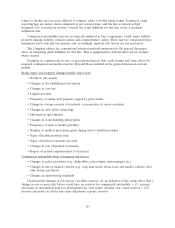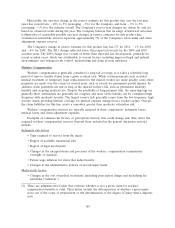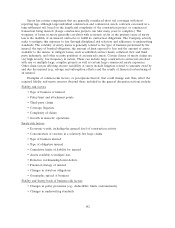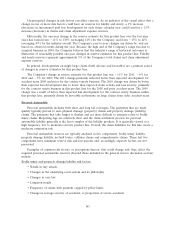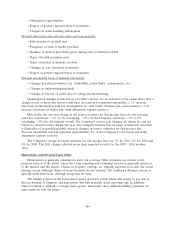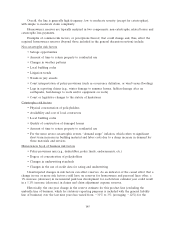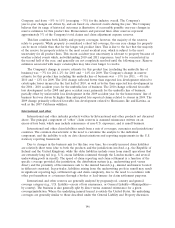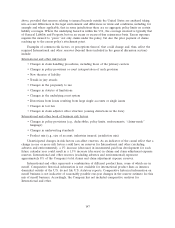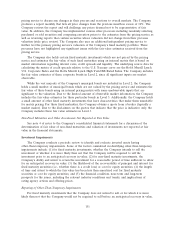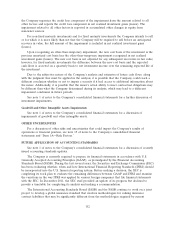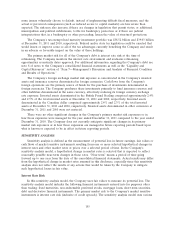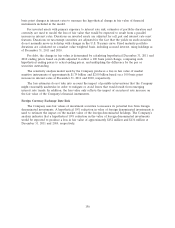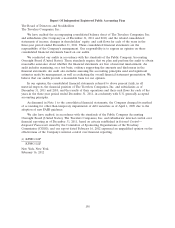Travelers 2011 Annual Report Download - page 161
Download and view the complete annual report
Please find page 161 of the 2011 Travelers annual report below. You can navigate through the pages in the report by either clicking on the pages listed below, or by using the keyword search tool below to find specific information within the annual report.insurance companies’ obligation to pay a pro rata share based on each company’s voluntary market
share of written premium in each state in which it is a pool participant. In the event a member of a
mandatory pool or association defaults on its share of the pool’s or association’s obligations, the other
members’ share of such obligation increases proportionally.
On August 20, 2010, in a reinsurance dispute in New York state court captioned United States
Fidelity & Guaranty Company v. American Re-Insurance Company, et al., the trial court granted summary
judgment for United States Fidelity and Guaranty Company (USF&G), a subsidiary of the Company,
and on October 25, 2010, entered judgment against American Re-Insurance Company, a subsidiary of
Munich Re (American Re) and three other reinsurers, awarding USF&G $251 million plus
pre-judgment interest in the amount of $169 million. The judgment, including the award of interest,
was appealed to the New York Supreme Court, Appellate Division, First Department. On January 24,
2012, the Appellate Division affirmed the judgment, which, as of that date, totaled $467 million,
comprising the judgment of $251 million and interest of $216 million (including post-judgment interest).
Post-judgment interest continues to accrue (without compounding) at the rate of 9% until the judgment
is paid. On January 30, 2012, the reinsurers filed a motion with the Appellate Division seeking
permission to appeal its decision to the New York Court of Appeals. Whether the Appellate Division
grants permission to appeal is within its discretion. The $251 million awarded by the court represents
the amount owed to USF&G under the terms of the disputed reinsurance agreements and is reported
as part of reinsurance recoverables in the Company’s consolidated balance sheet. The interest awarded
by the Court, including post-judgment interest, is treated for accounting purposes as a gain contingency
in accordance with FASB Topic 450, Contingencies, and accordingly has not been recognized in the
Company’s consolidated financial statements.
Investment Valuation and Impairments
Fair Value Measurements
The Company’s estimates of fair value for financial assets and financial liabilities are based on the
framework established in the fair value accounting guidance. The framework is based on the inputs
used in valuation, gives the highest priority to quoted prices in active markets, and requires that
observable inputs be used in the valuations when available. The disclosure of fair value estimates in the
fair value accounting guidance hierarchy is based on whether the significant inputs into the valuation
are observable. In determining the level of the hierarchy in which the estimate is disclosed, the highest
priority is given to unadjusted quoted prices in active markets and the lowest priority to unobservable
inputs that reflect the Company’s significant market assumptions. The level in the fair value hierarchy
within which the fair value measurement is reported is based on the lowest level input that is significant
to the measurement in its entirety. The three levels of the hierarchy are as follows:
— Level 1—Unadjusted quoted market prices for identical assets or liabilities in active markets
that the Company has the ability to access.
— Level 2—Quoted prices for similar assets or liabilities in active markets; quoted prices for
identical or similar assets or liabilities in inactive markets; or valuations based on models
where the significant inputs are observable (e.g., interest rates, yield curves, prepayment
speeds, default rates, loss severities, etc.) or can be corroborated by observable market data.
— Level 3—Valuations based on models where significant inputs are not observable. The
unobservable inputs reflect the Company’s own assumptions about the inputs that market
participants would use.
Valuation of Investments Reported at Fair Value in Financial Statements
The fair value of a financial instrument is the estimated amount at which the instrument could be
exchanged in an orderly transaction between knowledgeable, unrelated, willing parties, i.e., not in a
149


